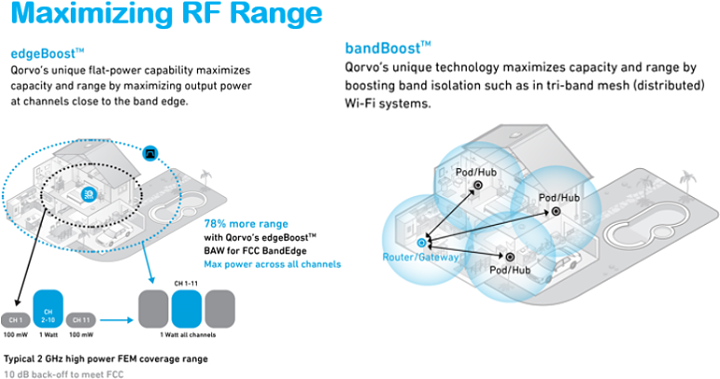Beyond the Mobile Phone: Designing Wi-Fi FEMs into AR/VR and IIOT
January 17, 2022
Introduction
For many years Wi-Fi has been heavily leveraged as a communication technology. We have all grown to see it when we move around our world – linking to it in our homes, businesses, in our local mall, hospitals, coffee shops, and the list goes on. We expect and know it will just work and that we can easily access it with our latest mobile devices. But, as with all other technologies, Wi-Fi is advancing. The Wi-Fi Alliance and manufacturers are pushing it into higher frequency realms, faster upload and download speeds, and smaller form-factors. This is why Wi-Fi is showing up in many more applications than ever before.

Benefits of Wi-Fi 6 and 6E
Since the inception of the 802.11 Wi-Fi standard in 1997, the Institute of Electrical and Electronics Engineering (IEEE) has released 20 different 802.11 specifications as of the date of this blog post. In 2018, to simplify how these specifications deliver capabilities and benefits, the Wi-Fi Alliance introduced a generational naming scheme, beginning with Wi-Fi 4 for 802.11n to Wi-Fi 7 for 802.11be (in development). The latest production generation is Wi-Fi 6, which includes the introduction of the recently approved 6 GHz spectrum (referred to as Wi-Fi 6E). As shown in Figure 1, Wi-Fi 6, 6E and 7 enables new frequency bands in the 6 and up to the 7 GHz realm.

Figure 1: Wi-Fi 6, 6E, and 7 frequency bands
Wi-Fi 6 (and 6E) introduced enhancements to Wi-Fi 5. These enhancements enable higher capacity, better signal reliability, and greater speed. Key features/benefits of Wi-Fi 6 include:
- Uplink MIMO—Wi-Fi 5 supports multiuser MIMO, but only in downlink mode. Wi-Fi 6 includes uplink, so multiple users can simultaneously upload and download data.
- Wider modulation—Wi-Fi 6 with 1024 QAM has a 10-bit modulation scheme (compared to 8-bit 256 QAM in Wi-Fi 5), which delivers better throughput and 25% higher capacity per symbol.
- Improved capacity and efficiency—Wi-Fi 6 uses Orthogonal Frequency Division Multiplexing Access (OFDMA) instead of Orthogonal Frequency Division Multiplexing (OFDM) in Wi-Fi 5, allowing FDD versus TDD and resource unit allocation within a given channel. Subcarrier spacing is reduced to 78.125 kHz—one-quarter of Wi-Fi 5 spacing—and symbols are 4x longer. Together, these changes mean the system is more efficient and can upload or download multiple data packets simultaneously, rather than one at a time.
- Schedule-based operation—In Wi-Fi 6, the access point dictates when a device will operate, thus handling clients more efficiently. Resource scheduling also significantly reduces the power consumption during sleep time, improving battery life for clients.
- Multi-band—Wi-Fi 5 and Wi-Fi 4 operate in the 2.4 GHz and 5 GHz spectrum only; Wi-Fi 6E operates in 2.4 GHz, 5 GHz, and the recently opened 6 GHz spectrums (indicating Wi-Fi 6E).
Exciting New Use Cases for Wi-Fi 6/6E
The value impact of Wi-Fi continues to be enormous. According to the latest Global Economic Value of Wi-Fi study by the Wi-Fi Alliance, economic value since 2018 has grown nearly 1.7x from USD 1.96 trillion to 3.3 trillion. It is forecasted to reach 4.9 trillion by 2025. This is a clear indicator of the importance Wi-Fi continues to have across worldwide consumer and commercial markets. Wi-Fi 6/6E is already in new mobile phones, routers, and network adapters, paving the way for more applications that demand higher bandwidth and lower latency both in the home and industrial operations. These new applications are made possible with new Wi-Fi 6 Front-End Modules (FEMs) and filter designs that deliver the capabilities needed for optimized Wi-Fi 6/6E in both consumer premise equipment (CPE) and mobile devices.
With access points and network adapters supporting Wi-Fi 6/6E capacities, speeds, and Quality of Service (QoS) requirements, markets are poised for new bandwidth-demanding and latency-sensitive products. These include the following:
Get More from Our
Wi-Fi Experts
Wi-Fi Tech & Trends is our blog series that features insights from Qorvo Wireless Connectivity Solution experts. In these posts, you can gain insight on the latest Wi-Fi design tips, trends and innovative solutions.
- Home/Consumer—Augmented Reality (AR)/Virtual Reality (VR) goggles and projectors, high-resolution cameras, and other artificial intelligence (AI) assisted media devices that need high bandwidth and low latency for real-time, or near real-time, video response.
- Industrial/Commercial—Industrial Internet of Things (IIoT) applications, such as cameras and other real-time instrumentation, that require more deterministic network behavior to meet quality and safety requirements in production lines, refinery operations, etc.
- Military—AR goggles and other visual-assistance systems that need security and real-time-like determinism in the field.
Although the Wi-Fi Alliance continues to work on many of the individual standard details in each of these application areas—the technology is available and ready.
As mobile devices, these require Wi-Fi 6/6E solutions that occupy very little space while delivering high-bandwidth, low-latency throughput, deterministic-like response, low power consumption, linearity, and interference mitigation.
Challenges for Small and Mobile Designs
Designing for Wi-Fi 6 in more compact devices is not unlike designing for Mobile phones. The challenges come from ensuring the same networking capabilities and adherence to RF requirements as in routers and network adapters but using much smaller IC devices at low power. Some of these challenges include the following:
Trapping and filtering—As seen with Wi-Fi 5, higher frequencies introduce new challenges. 6 GHz Wi-Fi frequencies have very narrow transition bands. Achieving rejection that meets system isolation with minimal insertion loss becomes a more significant challenge in small spaces; there’s no space for shielding or discrete filter components. Whether working in 5 or 6 GHz, Qorvo’s compact Bulk Acoustic Wave (BAW), band edge, and broadband filters eliminate the need for shielding hardware around closely aligned components. Integrating these filters inside the RF front-end meets coexistence needs in small spaces.

Figure 2: Where edgeBoost, coexBoost, and bandBoost filter technology is used
Interference—Users really don’t care much about what frequency (or technology) they’re running, as long as they can connect. Many devices support multiple radios, so it’s critical for Wi-Fi 6 front ends to co-exist with other technologies. Qorvo high-Q BAW filters for Wi-Fi 6 offer many advantages, including:
- Extremely steep skirts
- Significant size reductions
- Resolves coexistence of Wi-Fi and LTE signals within the same device or near one another
Qorvo’s filters enable high-performance coexistence, allowing Wi-Fi transmitters to operate close to the upper and lower FCC band edges.
Range—Smaller devices with less internal real estate can limit the reach of Wi-Fi. Higher frequencies deliver more bandwidth but are less able to penetrate physical obstructions. Using BAW technology like edgeBoost and bandBoost filters, as shown in Figure 3, helps designers maximize RF range in their systems. Moreover, efficient energy usage and an integrated antenna allow more capabilities to be delivered in smaller spaces. Qorvo’s new Wi-Fi 6/6E FEMs and filters meet the challenges of designing for small devices while helping minimize the amount of engineering effort to deliver an optimal solution.

Figure 3: BAW filters used to maximize RF range
Real Estate—Compacting all the necessary Wi-Fi 6 features and capabilities into less real estate presents the most considerable challenge for delivering innovative uses of next-generation Wi-Fi devices. Small spaces constrain the physical environment and require a closer analysis of the following:
- Power efficiency and heat dissipation—These can differ depending on the application. An IIoT edge sensor can be severely limited, while a solution designed into an automobile has greater tolerance.
- Antenna integration—Devices with integrated antennas eliminate the need for multiple external components.
- EVM—Error Vector Magnitude requirements are much tighter.
- Multi-band compatibility—As mentioned above, coexistence is a must.
- Environmental—Environments vary as widely as the application, from ultra-cold and dry to very hot and humid.
- Reliability—Wi-Fi has established an expected level of reliability with users and must be delivered irrespective of the device size.
Certifications—While Wi-Fi users expect a level of reliability, government and industry continue to require compliance to regulations and expected performance levels. Smaller devices can challenge designs to meet these requirements, including regulatory compliance (FCC, FDA, FAA, etc.), industrial certifications, and commercial partner certifications.
Final Thoughts from Kevin:
Wi-Fi continues to enable new technologies throughout our daily lives, well beyond the home gateway and smartphone. It is now becoming a new go-to technology in the military and industrial worlds—with recent technological developments like AR, VR, real-time industrial safety and more. Building on this momentum, Qorvo continues to collaborate with customers in these areas to help enable new design innovations with advancements driven by our Wi-Fi 6/6E FEMs.
Have another topic that you would like Qorvo experts to cover? Email your suggestions to the Qorvo Blog team and it could be featured in an upcoming post. Please include your contact information in the body of the email.
